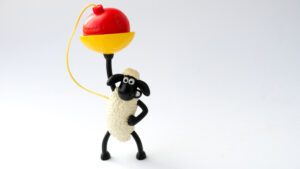Modern animated movies seem to always be computer-animated. What was once the stomping grounds of Pixar alone is now cluttered with the footprints of DreamWorks, Sony, Illumination, and even Disney. Even if the animation isn’t in 3D, computers are still used extensively. There are exceptions, of course: the hand-drawn anime films of Studio Ghibli, for example. But the most time-consuming and dedicated form of animation is stop-motion.

 Stop-motion animation is defined as “an animation technique that physically manipulates an object so it appears to move on its own.” If you’ve ever seen The Nightmare Before Christmas or a Wallace and Gromit short, you’re looking at stop-motion. It’s also a popular choice for aspiring animators and college students, as it doesn’t necessarily require drawing skills. All you need is a camera, patience, and time.
Stop-motion animation is defined as “an animation technique that physically manipulates an object so it appears to move on its own.” If you’ve ever seen The Nightmare Before Christmas or a Wallace and Gromit short, you’re looking at stop-motion. It’s also a popular choice for aspiring animators and college students, as it doesn’t necessarily require drawing skills. All you need is a camera, patience, and time.
Studios like Aardman and Laika exclusively make stop-motion films, and as such, aren’t in theaters with great frequency. According to insiders, Aadrman’s latest film Early Man only produced three seconds of footage in a single day. Because each second of a movie usually consists of 24 frames, 24 frames of footage must be arranged perfectly and captured without any sort of interference. Merely exhaling in the wrong direction could cause an entire reset.
It also means actions we normally take for granted have a lot more weight and effort put into them. In Laika’s 2016 movie Kubo and the Two Strings, a woman pulls herself up a beach in a storm. Sand and pebbles fly up as she crawls along. Easy to do with live action, but for stop-motion, it’s a painstaking process. Said Laika CEO Travis Knight, “every time she reaches out and claws into the sand, that’s all plasticine or clay surface that we have to carve into and move a frame at a time. We’d have little bits of sand that were flying up in the air, so we take these little bits of foam or clay, we put them on bug pins or wires or little bits of fishing line, and we have those elevated and move them a frame at a time to look like it’s bursting out of the ground.”
The effort, as stunning as the results are, does have its drawbacks. Director Wes Anderson said that the challenges facing him while working on Isle of Dogs were “peculiar. [F]or instance, it turns out this puppet doesn’t really smile. That could be like two-and-a-half years into the process and suddenly you’re faced with that.” While Anderson doesn’t go into details, it’s entirely possible that said character had dozens of smiling face plates, most of which were rendered useless. If Jack Skellington needed over 400 different heads to convey each syllable and emotion, logically Anderson’s dogs would have a similar amount.

That’s also not accounting for scale. Especially when using Claymation, the sets and props are minuscule. Yet the detail is often incredible. Sculptors work to make the characters and worlds we see on film as realistic as possible despite the fragility. It takes precise movements to make everything flow naturally and look believable, so the sculptors and animators had to work in tandem to create perfection.
 Stop-motion is often called a dying art. It’s a reasonable conclusion, seeing as large-scale releases are very rare. But as with many art forms, revenue and relevancy doesn’t exactly equate to success. Anderson’s Fantastic Mr. Fox barely made back its budget but holds a 93% rating on Rotten Tomatoes. 2015’s Anomalisa was called “the most human movie of the year” and was nominated for 32 awards, even though it underperformed at the box office. “Doing it for the art” is a phrase that is thrown around almost casually these days, but when it comes to stop-motion animation, it rings a little truer.
Stop-motion is often called a dying art. It’s a reasonable conclusion, seeing as large-scale releases are very rare. But as with many art forms, revenue and relevancy doesn’t exactly equate to success. Anderson’s Fantastic Mr. Fox barely made back its budget but holds a 93% rating on Rotten Tomatoes. 2015’s Anomalisa was called “the most human movie of the year” and was nominated for 32 awards, even though it underperformed at the box office. “Doing it for the art” is a phrase that is thrown around almost casually these days, but when it comes to stop-motion animation, it rings a little truer.
Learn more about the World of Production, and discover how microchips, solar farms, and game controllers are made.




